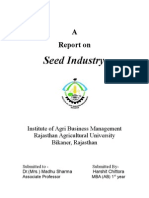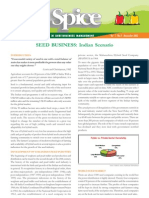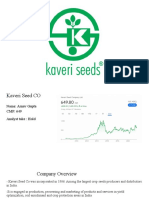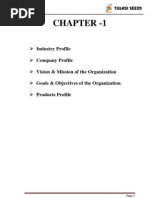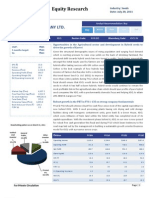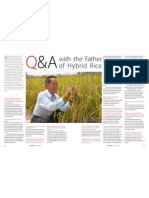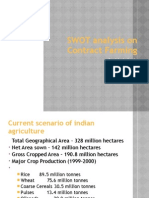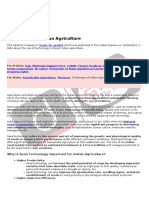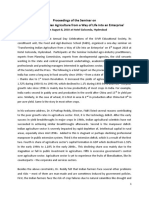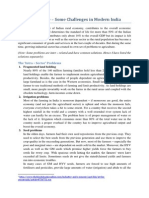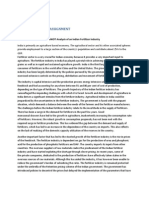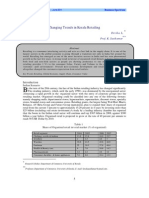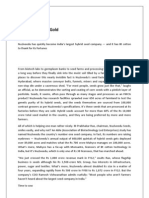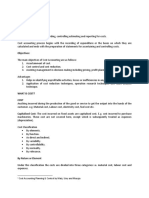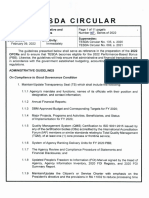India's Global Ranking in Agriculture:: Crop Production Area Yield
India's Global Ranking in Agriculture:: Crop Production Area Yield
Uploaded by
Rebecca GodwinCopyright:
Available Formats
India's Global Ranking in Agriculture:: Crop Production Area Yield
India's Global Ranking in Agriculture:: Crop Production Area Yield
Uploaded by
Rebecca GodwinOriginal Title
Copyright
Available Formats
Share this document
Did you find this document useful?
Is this content inappropriate?
Copyright:
Available Formats
India's Global Ranking in Agriculture:: Crop Production Area Yield
India's Global Ranking in Agriculture:: Crop Production Area Yield
Uploaded by
Rebecca GodwinCopyright:
Available Formats
Dormant risks in the seed industry: The adage, what you sow is what you reap, couldn't be more
true forIndian agricultural the sector. After all, agriculture is a key driver of the Indian economy, contributing around 25% of the gross domestic product (GDP) and providing livelihood to two-thirds of the population. India has the secondlargest area under cultivation and leads in the production of crops like rice, and wheat pulses. Yet, in terms of yields, the country ranks abysmallycomparison with the rest of the low in world. For instance, it is ranked 52nd in world in terms of the yield on rice and 147th in terms of the the yield on oil crops India's global ranking in agriculture). (see That's largely because of poor seed quality, high dependence on the monsoons, low farm mechanization, minuscule land holdings and the lack of understanding of improved farming methods. Hybrid seeds could, however, be one way of improving the agricultural sector's productivity. Today, of the around 140 million hectares under cultivation, only 12% are under hybrid seeds. With increasing population putting more pressure on the available land, farmers are bound to shift from conventional to hybrid seeds. This promises tremendous growth for the country's hybrid seed industry. India's global ranking in agriculture: Crop Rice Wheat Coarse grains Pulses Oil crops Cotton seed Production 2 2 4 1 5 4 Area 1 1 3 1 2 1 Yield 52 38 125 138 147 77
Seed industry - An overview: The Indian seed industry began developing with the green revolution 1960s. Initially, the in government-funded agencies developed and distributed hybrid seeds. Private sector players only started participating a large way in this sector around 15 years ago after the Seed Act 1988 in lifted many restrictions on seed development and trade.
Currently, there are around 400 players in the industry catering to a wide variety of crops from cotton and cereals to vegetables and fruits. Although
the industry has significant growth potential, growth rates are low at 34% as a result of low awareness and adaptability of farmers and the dearth of effective hybrid varieties in each crop that are suitable for the country's various agro-climatic conditions. smaller than that in many other countries In terms of value, the Rs. 40 billion seeds market is dominated by private players, who have a 70% share, while the remaining share is held by public varieties developed by government-funded organizations like the agricultural universities. In terms of volume, however, the situation is quite the reverse as public varieties are popular in food crops like paddy and wheat where seed prices are low whereas private players are mainly active in crops like cotton, cereals and vegetables, where realizations are relatively higher. Only a few companies like Nuziveedu Seeds Ltd, Mahyco and Paras Extra Growth Seeds have a turnover of over Rs. 1 billion. Many MNC seed conglomerates are also active in India through tieups or subsidiaries like Monsanto, which is present through Monsanto Mahyco, and Bayer Cropscience with ProAgro. Although the seed industry has an enormous growth potential, it carries some unique risk factors that need to be considered from a credit perspective. Over-dependence on cotton: Cotton is one of the few crops, which gives both volumes and better realizations and more than one-fourth of the industry's turnover comes from cotton hybrids. The importance of cotton for the top line of any seed company can be gauged from the fact that highyielding hybrid cotton seeds fetch around Rs. 400 per packet while similar maize, bajra and jowhar seeds sell for less than Rs. 35. This has resulted in more private and MNC seed companies getting into cotton. In fact, all the big seed companies with a turnover of over Rs. 1 billion are largely into cotton. Some of these companies depend on one or two high-performing hybrids for a major chunk of their revenues. This high dependence on cotton exposes the companies to the risk of lower demand Consequently, the seed industry in India is far
due to: Changes in area under cotton cultivation, which, in turn, depends on the prevailing and expected prices of cotton. Competitors coming out with better hybrids and hampering the prospects of other players. These risks can be mitigated by having a wide product portfolio so that even if there is a drop in demand for one crop, the top line is protected to a certain extent and farmers too are retained within the company's fold. Research&Development: R&D is the first and most critical endeavor of a seed company. It typically takes Rs. 50 to 100 million over a period of seven to eight years to commercialize a hybrid. With most Indian seed companies being small, R&D efforts are not very effective. Even after a hybrid is successful, challenges remain in the form of retaining the purity of the hybrid season after season, which requires proper maintenance breeding of the parent variety. Also, the R&D effort need to be market oriented to take into account the needs of the end user (say in cotton, the needs of the textile industry in terms of whiteness, lustre, staple length and strength or in vegetables, consumer preferences in terms of color, size and taste) so that when the variety is launched after incurring so much expenditure, it is accepted by the market. R&D is a key differentiator in this industry and companies with good R&D facilities are better placed to succeed than others. Lifecycle risk: On an average, the life cycle of a hybrid is eight to ten years after which, newer and better varieties typically outperform older ones. Hence, even though a particular hybrid variety might achieve high sales and better margins in the introductory period, these may not be sustainable for long. To remain ahead of the market, the company has to keep churning out better varieties at least once every four years. In the long run, then, only those seed companies with adequate R&D infrastructure and where the management is committed to developing better varieties have a higher chance of survival. Long production periods: Hybrid seed production takes place in two stages: preparation of foundation seeds and production of hybrid seeds from the foundation seeds by crossing the two vareties. As each stage is seasonal, production has to be planned two seasons ahead, which, in the case of crops like cotton, can be as long as two years. Hence, no changes in seed production can be carried out based on the current demand estimates as the actual production has begun much earlier.
In contrast with the long production period, sales typically take place within a few weeks prior to the sowing season. For example, cotton seed sales take place in May and June. This short sales window increases the company's vulnerability to fluctuations in demand. The inflexibility on the production side and the extremely
short sales period exposes companies to a sudden inventory pile-up if sales do not take place as projected, which could lead to liquidity problems. It also increases costs in terms of storage and the consequent risks of damage unless the company has a good storage facility. Here, the risk mitigants could be better forecasting abilities, better working capital management and the financial strength to withstand shocks in demand patterns. Risks in contract farming: Unlike abroad, in India, hybrid seed production from the basic foundation seeds is outsourced to thousands of contract farmers, most of whom have miniscule land holdings. Many such farmers do contract production for more than one seed company besides growing their normal varieties. This enhances the possibility of unintended cross- pollination, resulting in poor hybrid quality. In such a scenario, meticulous testing of hybrids is a must to maintain the promised yield. But unlike other industries, where quality controls takes a few minutes or hours, in seeds, it takes months because the genetic purity of a hybrid can only be ascertained at the flowering stage. This necessitates a grow out test (GOT) wherein a sample is grown in trial fields till the flowering stage to ascertain the hybrid's quality. Apart from this, moisture content and vigor also need to be checked. Any lapse on the quality front can spell disaster for both farmers (due to poor yields) and the seed company. The risk mitigants could be strong long-term relationships with contract farmers and geographical diversity in contract farming. If the seed industry carries these unique risks, on the bright side, it also has a lot of positive aspects and opportunities for growth. For one, the scope for expansion in India is huge, which despite having the second-largest area under cultivation, has a fairly small seed industry. Also, seeds being a critical input, farmers are ready to pay more for a better yielding hybrid, which means meritorious seed companies are sure to be rewarded with better realizations. Moreover, sales are mostly on a cash and carry basis, which is in direct contrast with other agricultural inputs like pesticides, where receivables are very high. Cash realizations reduce the liquidity pressure on seed companies, which otherwise would have been higher given the long production periods Export Opportunities: Currently, seed exports from India are minuscule compared to the actual potential. Valued at Rs. 1 billion, they account far less than 1% of global seed exports. The lack of highly productive and widely compatible seeds is the main reason for this dismal export performance. Yet, the country's varied agro-climatic conditions and cheap labour force can utilized to convert it in to a seed hub with the help of initiatives from private sector players and favorable government policies. The Road Ahead: The Indian seed industry is still in a nascent stage. The growing demand for agricultural products, driven by the ever-increasing population and pressure on land, could result in the rapid growth of hybrid varieties in the coming
decades. This, coupled with export opportunities and favorable legislation, can take this industry to fresh heights. CRISIL believes that although the industry's credit risk is moderately high today, going forward, seed companies having good R&D, distribution and storage facilities and a wide product portfolio are likely to emerge stronger.
You might also like
- Akuntansi Keuangan Lanjutan - Baker (10 E)Document1,086 pagesAkuntansi Keuangan Lanjutan - Baker (10 E)Nabila Nur IzzaNo ratings yet
- Reaserch PaperDocument43 pagesReaserch PaperSushant Sharma100% (1)
- India Seed Industry AnalysisDocument28 pagesIndia Seed Industry Analysisamardeep11No ratings yet
- Seed Business Indian ScnerioDocument8 pagesSeed Business Indian ScnerionagababjiNo ratings yet
- Structure of Seed IndustryDocument5 pagesStructure of Seed IndustrySanjayBagariaNo ratings yet
- SeedWorld2019 Report PDFDocument8 pagesSeedWorld2019 Report PDFDIPIN PNo ratings yet
- NIAM ReportDocument44 pagesNIAM ReportSudeep KeshriNo ratings yet
- Market ForecastDocument3 pagesMarket ForecastAbhijeet SabatNo ratings yet
- Marketing of Seeds in Bhadradri Kothagudem District SynopsisDocument14 pagesMarketing of Seeds in Bhadradri Kothagudem District Synopsiskamepalli priyaNo ratings yet
- Kaveri SeedDocument39 pagesKaveri SeedAnirudhNo ratings yet
- SEED INUDSTRY SWOT AnalysisDocument107 pagesSEED INUDSTRY SWOT AnalysisPrashanth PB82% (11)
- Sales and Distribution Management: "Siffco Agro Chemicals Limited"Document11 pagesSales and Distribution Management: "Siffco Agro Chemicals Limited"srijit verma100% (1)
- Eco Project Content Bumper ProductionDocument28 pagesEco Project Content Bumper ProductionDk Crafts craftyhubNo ratings yet
- Agrochemical (Or Agrichemical), A Contraction of Agricultural Chemical, Is A GenericDocument10 pagesAgrochemical (Or Agrichemical), A Contraction of Agricultural Chemical, Is A GenerictanvimhatreNo ratings yet
- 10) Agriculture in IndiaDocument48 pages10) Agriculture in Indiaj73774352No ratings yet
- Kaveri Seed Company LTDDocument9 pagesKaveri Seed Company LTDinuniversalNo ratings yet
- RT Vol. 11, No. 3 Q&A With The Father of Hybrid RiceDocument1 pageRT Vol. 11, No. 3 Q&A With The Father of Hybrid RiceRice TodayNo ratings yet
- SWOT ANALYSIS of Agro Chemical IndustryDocument4 pagesSWOT ANALYSIS of Agro Chemical Industryjaya rani dasNo ratings yet
- A Review: The Indian Seed Industry, Its Development, Current Status and FutureDocument7 pagesA Review: The Indian Seed Industry, Its Development, Current Status and Futurekomal100% (1)
- A Review: The Indian Seed Industry, Its Development, Current Status and FutureDocument7 pagesA Review: The Indian Seed Industry, Its Development, Current Status and FutureharshNo ratings yet
- My Corporate FarmingDocument15 pagesMy Corporate Farming42-Promit Mandal A-14No ratings yet
- SWOT Analysis On Contract FarmingDocument29 pagesSWOT Analysis On Contract FarmingsachinNo ratings yet
- Agrochemicals 2011Document43 pagesAgrochemicals 2011Mahima Nanda Talwar100% (1)
- Contract Farming PepsicoDocument3 pagesContract Farming PepsicoBholendra SinghNo ratings yet
- Food Product DevelopmentDocument4 pagesFood Product DevelopmentMANSHI RAINo ratings yet
- Indian Agriculture SectorDocument5 pagesIndian Agriculture SectorNikhil JainNo ratings yet
- Relevance of GM Technology of Indian Agriculture and Food Security - AdvDocument5 pagesRelevance of GM Technology of Indian Agriculture and Food Security - AdvSaurabh SinghNo ratings yet
- Integrity in The Indian Organic Cotton Value Chain: A Summary of Issues and Gaps For Potential ActionDocument13 pagesIntegrity in The Indian Organic Cotton Value Chain: A Summary of Issues and Gaps For Potential ActionImon KhandakarNo ratings yet
- Corporate Sectors in AgribusinessDocument20 pagesCorporate Sectors in AgribusinessVijaya MishraNo ratings yet
- Project Report On AgrochemicalsDocument31 pagesProject Report On Agrochemicalskamdica78% (18)
- Economic Impacts of Transgenic Crops: Section A: Framing The Debate Section B: The Evidence So FarDocument45 pagesEconomic Impacts of Transgenic Crops: Section A: Framing The Debate Section B: The Evidence So FartabVlaeNo ratings yet
- Agrochemical Sector IC Feb'14 EisecDocument51 pagesAgrochemical Sector IC Feb'14 EisecjehanbhadhaNo ratings yet
- Agriculture Heritage Crops and Its Importance: A Crop Is A Plant or Animal Product That Can BeDocument17 pagesAgriculture Heritage Crops and Its Importance: A Crop Is A Plant or Animal Product That Can BeSachin SrivastavaNo ratings yet
- Technology in AgricultureDocument6 pagesTechnology in AgricultureAryan RajNo ratings yet
- Factor Affecting Seed MarketingDocument9 pagesFactor Affecting Seed Marketingkanavkhajuria401No ratings yet
- Insights Into Editorial Seed Bill Must Serve Farmers Not MNCsDocument4 pagesInsights Into Editorial Seed Bill Must Serve Farmers Not MNCsrishabh shahNo ratings yet
- Seminar ReportDocument6 pagesSeminar ReportBalasubramanian SankaranarayananNo ratings yet
- Contract FarmingDocument22 pagesContract FarmingAnkush PumbaNo ratings yet
- Agriculture - Some Challenges in Modern IndiaDocument6 pagesAgriculture - Some Challenges in Modern IndiaRavikanth ReddyNo ratings yet
- Seed ProductionDocument7 pagesSeed ProductionChinmaya Sahu100% (1)
- Private Sector Intervention in Indian Fruit & Vegetable Sector For Increasing Rural Wealth: A Case StudyDocument12 pagesPrivate Sector Intervention in Indian Fruit & Vegetable Sector For Increasing Rural Wealth: A Case StudyAsian Development BankNo ratings yet
- Importance of Agriculture To Economic DevelopmentDocument37 pagesImportance of Agriculture To Economic DevelopmentJahnabi GoswameeNo ratings yet
- Agribusiness-Importance, Challenges and OpportunitiesDocument4 pagesAgribusiness-Importance, Challenges and Opportunitiessuriya kishoreNo ratings yet
- Ya 1Document18 pagesYa 1krishnatradingcompany udtNo ratings yet
- Plant Growth Regulators - PGR - MarketDocument15 pagesPlant Growth Regulators - PGR - MarketAgricultureNo ratings yet
- Eco PPT PersonalDocument14 pagesEco PPT Personalyash dhirNo ratings yet
- Indian Seed IndustryDocument24 pagesIndian Seed Industrypradip_kumarNo ratings yet
- SEED INUDSTRY SWOT AnalysisDocument107 pagesSEED INUDSTRY SWOT AnalysisABIN JOHNNo ratings yet
- Kargil Belludi, HariharDocument46 pagesKargil Belludi, Hariharsantoshpatelpatel4985No ratings yet
- Biotech Crucial For Food SecurityDocument4 pagesBiotech Crucial For Food Securitynkmmpl.98No ratings yet
- Vikram ProjectDocument55 pagesVikram ProjectAshwini H RNo ratings yet
- SWOT ANALYSIS of Agro Chemical IndustryDocument4 pagesSWOT ANALYSIS of Agro Chemical IndustryVarsha Kasture86% (7)
- Nath Bio-Genes at Inflection Point-2Document9 pagesNath Bio-Genes at Inflection Point-2vinodtiwari808754No ratings yet
- Chickpea Manual FullDocument28 pagesChickpea Manual Fullfarooqzai1No ratings yet
- Status of Hybrid Seed Production in Pakistan and Its Role in Boosting Up Agricultural ProductionDocument32 pagesStatus of Hybrid Seed Production in Pakistan and Its Role in Boosting Up Agricultural ProductionMuhammad Boota Sarwar100% (6)
- Growth of Corporate FarmingDocument22 pagesGrowth of Corporate FarmingNiraj PatilNo ratings yet
- Integrated Pest Management (IPM) farmer Field School (FFS): A Guide for Facilitators of FFS on Maize with Special Emphasis on Fall ArmywormFrom EverandIntegrated Pest Management (IPM) farmer Field School (FFS): A Guide for Facilitators of FFS on Maize with Special Emphasis on Fall ArmywormNo ratings yet
- Status of Seed Legislation and Policies in the Asia-Pacific RegionFrom EverandStatus of Seed Legislation and Policies in the Asia-Pacific RegionNo ratings yet
- Disaster Risk Reduction at Farm Level: Multiple Benefits, No Regrets: Results From Cost-Benefit Analyses Conducted in a Multi-Country Study, 2016-2018From EverandDisaster Risk Reduction at Farm Level: Multiple Benefits, No Regrets: Results From Cost-Benefit Analyses Conducted in a Multi-Country Study, 2016-2018Rating: 4 out of 5 stars4/5 (1)
- Iaa MB 5Document4 pagesIaa MB 5Rebecca GodwinNo ratings yet
- QuestionnaireDocument3 pagesQuestionnaireRebecca GodwinNo ratings yet
- Book 1Document1 pageBook 1Rebecca GodwinNo ratings yet
- Nu Zive Edu SeedsDocument5 pagesNu Zive Edu SeedsRebecca GodwinNo ratings yet
- Principles of Business FinanceDocument2 pagesPrinciples of Business FinanceVishal GaonkarNo ratings yet
- Module 1 - Overview of Cost AccountingDocument7 pagesModule 1 - Overview of Cost AccountingMae JessaNo ratings yet
- Week 9Document4 pagesWeek 9Anabel BahintingNo ratings yet
- CAF-9 Mock (Q.P)Document5 pagesCAF-9 Mock (Q.P)manadish nawazNo ratings yet
- Resident BookletDocument32 pagesResident BookletGopal GopinathNo ratings yet
- HR Director VP Manufacturing in Dallas Fort Worth TX Resume Nancy GenglerDocument2 pagesHR Director VP Manufacturing in Dallas Fort Worth TX Resume Nancy GenglerNancy Gengler1No ratings yet
- Decoding The Growth Target: NotesDocument6 pagesDecoding The Growth Target: NotesKannan pNo ratings yet
- Goods and Service TaxDocument7 pagesGoods and Service TaxArrya SarkarNo ratings yet
- Protest of Bill of ExchangeDocument2 pagesProtest of Bill of ExchangeMark DungoNo ratings yet
- NBP Funds: NBP Aitemaad Mahana Amdani Fund (NAMAF)Document1 pageNBP Funds: NBP Aitemaad Mahana Amdani Fund (NAMAF)Sajid rasoolNo ratings yet
- Chap 18Document32 pagesChap 18ridaNo ratings yet
- Problem 1 - The Accounts and Their Balances in The Ledger of Generic Pharma On December 31Document2 pagesProblem 1 - The Accounts and Their Balances in The Ledger of Generic Pharma On December 31Pepegon SalinasNo ratings yet
- DRS Business Case - Barnet CouncilDocument161 pagesDRS Business Case - Barnet CouncilMisterMustardNo ratings yet
- Jose Rizal Memorial State University: The Premier University in Zamboanga Del NorteDocument71 pagesJose Rizal Memorial State University: The Premier University in Zamboanga Del NorteDia Mae GenerosoNo ratings yet
- AAII Dividend Investing - User GuideDocument27 pagesAAII Dividend Investing - User Guideyounghack32100% (1)
- Investors Financial Investments Towards Local Chit FundsDocument10 pagesInvestors Financial Investments Towards Local Chit FundsDurai Mani100% (1)
- PRMG30 Course Material - SP 15Document167 pagesPRMG30 Course Material - SP 15Nasser Abdel RaoufNo ratings yet
- Wcms 736562Document100 pagesWcms 736562Anjali jangidNo ratings yet
- 7 Chart Patterns Discount Investment and Stock Market Trading PDFDriveDocument92 pages7 Chart Patterns Discount Investment and Stock Market Trading PDFDriveTuan Anh Nguyen100% (1)
- Al Faisal Holdings Company Profile 2024Document67 pagesAl Faisal Holdings Company Profile 2024278rry77xcNo ratings yet
- Lesson 7 - CAPM - Prep - Cost Management - V2Document37 pagesLesson 7 - CAPM - Prep - Cost Management - V2Kamran AnjumNo ratings yet
- Paraphrasing ActivitiesDocument2 pagesParaphrasing ActivitiesMhalen Atienza FracNo ratings yet
- Payment of Bonus ActDocument42 pagesPayment of Bonus ActprateekfreezerNo ratings yet
- TESDA Circular No. 007-2022Document11 pagesTESDA Circular No. 007-2022shellaNo ratings yet
- Rate NPV 351,212,178.13 365,660,986.27 290,844,716.89 207,520,203.54 Irr 180% 128% 189% 329%Document1 pageRate NPV 351,212,178.13 365,660,986.27 290,844,716.89 207,520,203.54 Irr 180% 128% 189% 329%pinkieNo ratings yet
- Module 3 Resource Allocation Home Depot RrodriguezDocument5 pagesModule 3 Resource Allocation Home Depot Rrodriguezapi-556507529No ratings yet
- Assignment On Investment OptionsDocument6 pagesAssignment On Investment OptionsHariom AgarwalNo ratings yet
- Accountant JDDocument2 pagesAccountant JDBoy Ice PickNo ratings yet
- Financial Accounting and Reporting (Accounting 15) InvestmentsDocument10 pagesFinancial Accounting and Reporting (Accounting 15) InvestmentsJoel Christian MascariñaNo ratings yet


